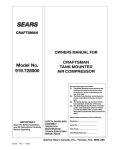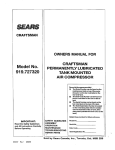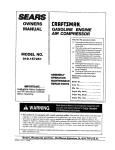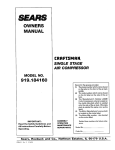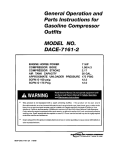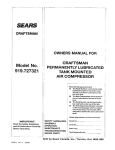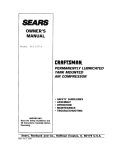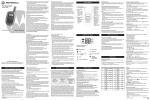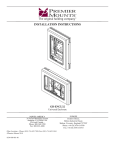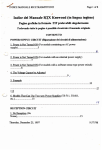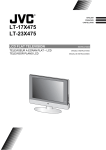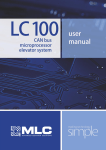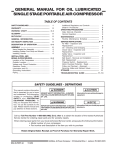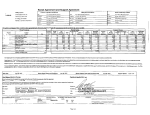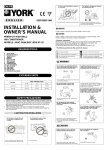Download Craftsman 919.728000 Troubleshooting guide
Transcript
S£ S
CRAFTSMAN
OWNERS MANUAL FOR
CRAFTSMAN
TANK MOUNTED
AIR COMPRESSOR
Model No.
919.728000
Record in the spaces provided.
(1) The Model Number can be found on the
maintenance label on top of the motor
shroud or on the bar code label on the
rear of air tank.
(2)
The Date Code Number can be found on
the bar code label on the rear of the air
tank.
(3)
The Serial Number can be found on the
bar code label on the rear of the tank.
(4)
The Tank Registration Number is located
on the metal data plate which is welded
onto the backside of the air tank. (This
data plate is painted the same color as the
tank.)
Retain these numbers for future reference.
IMPORTANT:
Read the Safety Guidelines
and All Instructions Carefully
Before Operating
SAFETY GUIDELINES
ASSEMBLY
OPERATION
MAINTENANCE
TROUBLESHOOTING
REPAIR PARTS
Sold
D21245
Rev. 0
6/29/00
by Sears
Canada,
Model No
Serial
No
Date Code
Tank Registration
Inc.,
No
Toronto,
Ont.
M5B
2B8
WARRANTY ......................................................... 2
SAFETY GUIDELINES ......................................... 2
WARNING CHART ............................................ 3-5
GENERAL INFORMATION ................................... 6
GLOSSARY .......................................................... 6
SPECIFICATION CHART ..................................... 7
DESCRIPTION OF OPERATION .......................... 7
TOOLS NEEDED FOR ASSEMBLY ...................... 7
ASSEMBLY .......................................................... 8
BREAK-IN PROCEDURES ................................... 8
Location of Air Compressor ............................ 8
Lubrication and Oil ......................................... 8
Grounding Instructions .................................... 6
Voltage and Circuit Protection ......................... g
Extension Cords ............................................. 10
Piping ............................................................. 10
Additional Regulators and Controls ................. 10
Break-in Procedure ......................................... 10
OPERATING PROCEDURES ............................... 11
FULL
ONE
YEAR
MAINTENANCE
...........................................................
Air Filter - Inspection and Replacement ..................
Check Valve -Replacement
....................................
Safety Valve _Inspection ........................................
Belt-Replacement
...................................................
Belt Guard - Removal and Installation ...................
Adjust Belt Tension .................................................
Pressure Switch - Replacement
.............................
Motor Overload Protector - Reset ...........................
12
12
12
12
13
13
13
13
13
Pulley and Flywheel _Alignment .............................
13
Servicing Intake and Exhaust Valves ...................... 13
Storage ...................................................................
14
TROUBLESHOOTING
GUIDE ................................
14-16
AIR COMPRESSOR
DIAGRAM ...................................
18
PARTS LIST .................................................................
19
COMPRESSOR
PUMP DIAGRAM ..............................
20
PARTS LIST .................................................................
21
HOW TO ORDER REPAIR PARTS ................ Back Cover
WARRANTY
ON AIR COMPRESSORS
If this air compressor
fails due to a defect in material or workmanship
within one year from the date
of purchase, RETURN IT TO THE NEAREST SEARS SERVICE CENTER THROUGHOUT CANADA AND
SEARS WILL REPAIR IT, FREE OF CHARGE.
If this air compressor
is used for commercial
days (90) from the date of purchase.
or rental purposes,
This Craftsman Air Compressor warranty gives you specific
rights which vary from province to province.
Sears
Canada,
Inc.,
Toronto,
the warranty
legal rights
Ont.
will apply for ninety
and you may have other
MSB
2B8
This manual contains information that is important for you to know and understand. This information relates to protecting
YOUR SAFETY and PREVENTING EQUIPMENT PROBLEMS. To help you recognize this information, we use the symbols
to the right. Please read the manual and pay attention to these sections.
P_I_,_,I_LHS[=!
DANGER indicates an imminently hazardous situation which, if
not avoided, will result in death or serious iniurv,
CAUTION indicates a potentially hazardous situation which, if
not avoided, _
resuR in minor or moderate iniurv.
WARNING indicates a potentially hazardous situation which, if
not avoided, could result in eath of serious i "u .
CAUTION used without the safety aFert symbol indicates a
potentiaUy hazardous situation which, if not avoided, _
result
in =)roDertv damaae.
_r_T_JILVJ_i
D21245
Rev. O
6/29/00
2 = ENG
SAVE THESE INSTRUCTIONS
--
IMPROPER OPERATION OR MAINTENANCE
OF THIS PRODUCT COULD RESULT IN SERIOUS INJURY AND PROPERTY
DAMAGE. READ AND UNDERSTAND ALL WARNINGS AND OPERATING INSTRUCTIONS
BEFORE USING THIS EQUIPMENT.
RISK OF EXPLOSION
WHAT
OR FIRE
CAN HAPPEN
HOW TO PREVENT IT
IT IS NORMAL FOR ELECTRICALCONTACTS WITHINTHE
MOTORAND PRESSURESWITCH TO SPARK.
ALWAYS OPERATE THE COMPRESSOR
LATED AREA FREE OF COMBUSTIBLE
GASOLINE OR SOLVENT VAPORS.
IF ELECTRICAL SPARKS FROM COMPRESSOR COME INTO
CONTACT WITH FLAMMABLE VAPORS, THEY MAY IGNITE,
CAUSING FIRE OR EXPLOSION.
IF SPRAYING FLAMMABLE MATERIALS, LOCATE COMPRESSOR AT LEAST 20 FEET AWAY FROM SPRAY AREA. AN
ADDITIONAL LENGTH OF HOSE MAY BE REQUIRED.
STORE FLAMMABLE MATERIALS
AWAY FROM COMPRESSOR.
RESTRICTING ANY OF THE COMPRESSOR VENTILATION
OPENINGS WILL CAUSE SERIOUS OVERHEATING AND
COULD CAUSE FIRE.
IN A WELL VENTIMATERIALS.
IN A SECURE LOCATION
NEVER PLACE OBJECTS AGAINST OR ON TOP OF COMPRESSOR. OPERATE COMPRESSOR IN AN OPEN AREA AT
LEAST 12 INCHES AWAY FROM ANY WALL OR OBSTRUCTION THAT WOULD RESTRICT THE FLOW OF FRESH AIR TO
THE VENTILATION OPENINGS.
OPERATE COMPRESSOR IN A CLEAN, DRY, WELL VENTILATED AREA. DO NOT OPERATE UNIT INDOORS OR IN ANY
CONFINED AREA.
UNATTENDED OPERATION OF THIS PRODUCT COULD
RESULT IN PERSONAL INJURY OR PROPERTY DAMAGE.
ALWAYS REMAIN IN A1-FENDANCE WITH THE PRODUCT
WHEN IT IS OPERATING.
.s,o ou,s..o
]
A/_:
THE FOLLOWING
CONDITIONS
COULD LEAD TO A WEAKENING OF THE TANK, AND RESULT IN A
VIOLENT TANK EXPLOSION AND COULD CAUSE PROPERTY DAMAGE OR SERIOUS INJURY.
WHAT CAN HAPPEN
HOW TO PREVENT IT
1. FAILURE TO PROPERLY DRAIN CONDENSED WATER
FROM THE TANK, CAUSING RUST AND THINNING OF THE
STEEL TANK.
DRAIN TANK DAILY OR AFTER EACH USE. IF TANK DEVELOPS A LEAK, REPLACE IT IMMEDIATELY WITH A NEW TANK OR
REPLACE THE ENTIRE COMPRESSOR.
2. MODIFICATIONS
NEVER DRILL INTO, WELD, OR MAKE ANY MODIFICATIONS
TO THE TANK OR ITS ATTACHMENTS.
OR AI_EMPTED
REPAIRS TO THE TANK.
3. UNAUTHORIZED MODIFICATIONS TO THE UNLOADER
VALVE, SAFETY VALVE, OR ANY OTHER COMPONENTS
WHICH CONTROL TANK PRESSURE.
THE TANK IS DESIGNED TO WITHSTAND SPECIFIC OPERATING
PRESSURES. NEVER MAKE ADJUSTMENTS OR PARTS
SUBSTITUTIONS TO ALTER THE FACTORY SET OPERATING
PRESSURES.
4. EXCESSIVE VIBRATION CAN WEAKEN THE AIR TANK
AND CAUSE RUPTURE OR EXPLOSION.
ATTACHMENTS
& ACCESSORIES:
EXCEEDING THE PRESSURE RATING OF AIR TOOLS, SPRAY
GUNS, AIR OPERATED ACCESSORIES, TIRES AND OTHER
INFLATABLES CAN CAUSE THEM TO EXPLODE OR FLY
APART, AND COULD RESULT IN SERIOUS INJURY.
3 --
FOR ESSENTIAL CONTROL OF AIR PRESSURE, YOU MUST
INSTALL A PRESSURE REGULATOR AND PRESSURE GAUGE
TO THE AIR OUTLET OF YOUR COMPRESSOR. FOLLOW THE
EQUIPMENT MANUFACTURERS RECOMMENDATION AND
NEVER EXCEED THE MAXIMUM ALLOWABLE PRESSURE
RATING OF ATTACHMENTS. NEVER USE COMPRESSOR TO
INFLATE SMALL LOW-PRESSURE OBJECTS SUCH AS
CHILDREN'S TOYS, FOOTBALLS, BASKETBALLS. ETC.
I:NG
D21245
Rev. 0
6/29/00
RISK
FROM
FLYING
OBJECTS
WHAT CAN HAPPEN
HOW TO PREVENT
THE COMPRESSED AIR STREAM CAN CAUSE SOFT TISSUE
DAMAGE TO EXPOSED SKIN AND CAN PROPEL DIRT, CHIPS,
LOOSE PARTICLES AND SMALL OBJECTS AT HIGH SPEED,
RESULTING IN PROPERTY DAMAGE OR PERSONAL INJURY.
IT
ALWAYS WEAR ANSI Z87.1 APPROVED SAFETY GLASSES
WITH SIDE SHIELDS WHEN USING THE COMPRESSOR.
NEVER POINT ANY NOZZLE OR SPRAYER TOWARD ANY
PART OF THE BODY OR AT OTHER PEOPLE OR ANIMALS.
ALWAYS TURN THE COMPRESSOR OFF AND BLEED PRESSURE FROM THE AIR HOSE AND TANK BEFORE ATi-EMPTING
MAINTENANCE, ATI'ACHING TOOLS OR ACCESSORIES.
RISK
TO BREATHING
WHAT CAN HAPPEN
HOW TO PREVENT
IT
ALWAYS OPERATE AIR COMPRESSOR OUTSIDE IN A CLEAN,
WELL VENTILATED AREA. AVOID ENCLOSED AREAS SUCH AS
GARAGES, BASEMENTS, STORAGE SHEDS, WHICH LACK A
STEADY EXCHANGE OF AIR. KEEP CHILDREN, PETS AND
OTHERS AWAY FROM AREA OF OPERATION.
THE COMPRESSED AIR FROM YOUR COMPRESSOR IS NOT
SAFE FOR BREATHING! THE AIR STREAM MAY CONTAIN
CARBON MONOXIDE. TOXIC VAPORS OR SOLID PARTICLES
FROM THE TANK.
NEVER INHALE AIR FROM THE COMPRESSOR EITHER
DIRECTLY OR FROM A BREATHING DEVICE CONNECTED TO
THE COMPRESSOR.
WORK IN AN AREA WITH GOOD CROSS-VENTILATION.
READ
AND FOLLOW THE SAFETY INSTRUCTIONS PROVIDED ON
THE LABEL OR SAFETY DATA SHEETS FOR THE MATERIAL
YOU ARE SPRAYING. USE A NIOSH/MSHA APPROVED
RESPIRATOR DESIGNED FOR USE WITH YOUR SPECIFIC
APPLICATION.
SPRAYED MATERIALS SUCH AS PAINT, PAINT SOLVENTS,
PAINT REMOVER, INSECTICIDES, WEED K_LLERS, CONTAIN
HARMFUL VAPORS AND POISONS.
--oF
,.,roc.,soc,
WHAT CAN HAPPEN
HOW TO PREVENT IT
YOUR AIR COMPRESSOR IS POWERED BY ELECTRICITY.
LIKE ANY OTHER ELECTRICALLY POWERED DEVICE, IF IT IS
NOT USED PROPERLY IT MAY CAUSE ELECTRIC SHOCK,
NEVER OPERATE THE COMPRESSOR OUTDOORS WHEN IT IS
RAINING OR IN WET CONDITIONS.
REPAIRS AI-rEMPTED BY UNQUALIFIED PERSONNEL CAN
RESULT IN SERIOUS INJURY OR DEATH BY ELECTROCUTION.
ANY ELECTRICAL WIRING OR REPAIRS REQUIRED ON THIS
PRODUCT SHOULD BE PERFORMED BY AUTHORIZED
SERVICE CENTER PERSONNELIN ACCORDANCE WITH
NATIONAL AND LOCAL ELECTRICAL CODES.
NEVER OPERATE COMPRESSOR
REMOVED OR DAMAGED.
ELECTRICAL GROUNDING:
FAILURE TO PROVIDE ADEQUATE
GROUNDING TO THIS PRODUCT COULD RESULT IN SERIOUS
INJURY OR DEATH FROM ELECTROCUTION,
SEE GROUNDING INSTRUCTIONS.
D21245
Rev, 0
6/29/00
4 --
WITH COVER COMPONENTS
MAKE CERTAIN THAT THE ELECTRICAL CIRCUIT TO WHICH
THE COMPRESSOR IS CONNECTED PROVIDES PROPER
ELECTRICAL GROUNDING, CORRECT VOLTAGE AND
ADEQUATE FUSE PROTECTION.
ENG
RISK FROM MOVING
PARTS
WHATCANHAPPEN
HOW TO PREVENT
IT
MOVING PARTS SUCH AS THE PULLEY, FLYWHEEL AND BELT
CAN CAUSE SERIOUS INJURY IF THEY COME INTO CONTACT
WITH YOU OR YOUR CLOTHING.
NEVER OPERATE THE COMPRESSOR WITH GUARDS OR
COVERS WHICH ARE DAMAGED OR REMOVED.
ATTEMPTING TO OPERATE COMPRESSOR WITH DAMAGED
OR MISSING PARTS OR AI"rEMPTING TO REPAIR COMPRESSOR WITH PROTECTIVE SHROUDS REMOVED CAN
EXPOSE YOU TO MOVING PARTS AND CAN RESULT IN
SERIOUS INJURY.
ANY REPAIRS REQUIRED ON THIS PRODUCT SHOULD BE
PERFORMED BY AUTHORIZED SERVICE CENTER PERSONNEL,
RISK
WHAT
OF BURNS
CAN HAPPEN
HOW TO PREVENT IT
TOUCHING EXPOSED METAL SUCH AS THE COMPRESSOR
HEADOR OUTLETTUBES, CAN RESULT IN SERIOUS BURNS.
NEVER TOUCH ANY EXPOSED METAL PARTS ON COMPRESSOR DURING OR IMMEDIATELY AFTER OPERATION. COMPRESSOR WILL REMAIN HOT FOR SEVERAL MINUTES AFTER
OPERATION.
DO NOT REACH AROUND PROTECTIVE SHROUDS OR A]q'EMPT
MAINTENANCE UNTIL UNIT HAS BEEN ALLOWED TO COOL.
RISK
WHAT
CAN
OF FALLING
HAPPEN
HOWTO PREVENT IT
A PORTABLE COMPRESSOR CAN FALL FROM A TABLE,
WORKBENCH OR ROOF CAUSING DAMAGE TO THE COMPRESSOR AND COULD RESULT IN SERIOUS INJURY OR
DEATH TO THE OPERATOR.
RISK
OF PROPERTY
(Fire,
ALWAYS OPERATE COMPRESSOR IN A STABLE SECURE
POSITION TO PREVENT ACCIDENTAL MOVEMENT OF THE
UNIT. NEVER OPERATE COMPRESSOR ON A ROOF OR
OTHER ELEVATED POSITION. USE ADDITIONAL AIR HOSE
TO REACH HIGH LOCATIONS.
DAMAGE
WHEN
COMPRESSOR
Inhalation,
Damage
TRANSPORTING
to Vehicle
WHAT CAN HAPPEN
HOW
OIL CAN LEAK OR SPILL AND COULD RESULT IN FIRE OR
BREATHING HAZARD, SERIOUS INJURY OR DEATH CAN
RESULT. OIL LEAKS WILL DAMAGE CARPET, PAINT OR OTHER
SURFACES IN VEHICLES OR TRAILERS.
ESW*99
Surfaces)
TO PREVENT
IT
ALWAYS PLACE COMPRESSOR ON A PROTECTIVE MAT WHEN
TRANSPORTING TO PROTECT AGAINST DAMAGE TO VEHICLE
FROM LEAKS. REMOVE COMPRESSOR FROM VEHICLE
IMMEDIATELY UPON ARRIVAL AT YOUR DESTINATION.
-- 9/26/99
5 -- ENG
D21245
Rev, 0
6/29/00
You have purchased an air compressor unit consisting
of an aluminum 2 cylinder, single-stage air compressor
pump (with cast iron sleeves), an air tank, wheels,
handle, associated controls and instruments.
Your air compressor can be used for operating paint
spray guns, air tools, caulking guns, grease guns, air
brushes, sandblasters,
inflating tires and plastic toys,
spraying weed killers, insecticides, etc. An air pressure regulator is required for most of these applications.
CFM: Cubic Feet per Minute.
SCFM: Standard Cubic Feet per Minute; a unit of
measure of air delivery.
PSI: Pounds per Square Inch; a unit of measure of
pressure.
ASME: American Society of Mechanical Engineers;
made, tested, inspected and registered to meet the
standards of the ASME.
Cut-In Pressure: While the motor is off, air tank
pressure drops as you continue to use your accessory.
When the tank pressure drops to a certain low level
and the pressure switch lever is in "Auto", the motor
will restart automatically. The low pressure at which
the motor automatically restarts is called "cut-in
pressure."
An air line filter is usually required for removal of
moisture and oil vapor in compressed air when a paint
spray gun is used.
An in-line lubricator is usually required for air tools to
prolong tool life.
Separate air transformers which combine the functions
of air regulation and/or moisture and dirt removal
should be used where applicable.
Cut-Out Pressure: When you turn on your air compressor and it begins to run, air pressure in the air tank
begins to build. It builds to a certain high pressure
before the motor automatically shuts off - protecting
your air tank from pressure higher than its capacity.
The high pressure at which the motor shuts off is
called "cut-out pressure."
CSA: Electrical products sold in Canada are required
to be certified to the applicable CSA standard (s).
Canadian Standards Association (CSA) is a standards
writing and safety testing organization. Products that
are CSA certified have been evaluated and tested and
found to meet or exceed the applicable CSA standard
(s) for safety and electrical performance.
919.728000
Model No.
Bore
2 3/8"
Stroke
1.35"
Voltage - Single Phase
120/240
MinimumBranch Circuit Requirement
15 amps
Fuse Type
Time Delay
Amperage at Maximum Pressure
15.0
Air Tank/Capacity
ASME/30 gal. (U.S.)
Approximate Cut-in Pressure
100
Approximate Cut-out Pressure
125
SCFM @40 psi
7.2
SCFM @90 psi
5.6
021245
Rev. 0
6/29/00
6 -- ENG
Air Compressor
Pump: To compress air, the piston
moves up and down in the cylinder. On the downstroke,
air is drawn in through the air intake valves. The exhaust
valves remain closed. On the upstroke of the piston, air
is compressed.
The intake valves close and compressed
air is forced out through the exhaust valves, through the
outlet tube, through the check valve and into the air tank.
Check Valve: When the air compressor is operating, the
check valve is "open", allowing compressed air to enter
the air tank. When the air compressor reaches "cut-out"
pressure, the check valve "closes", allowing air pressure to remain inside the air tank.
Pressure Switch; The pressure switch is fitted with a
small lever. It is labeled "Auto/O" for automatic run or
off. In the "O" position, the motor will not run. In the "Auto"
position, it automatically starts the motor when the air
tank pressure drops below the factory set "cut-in" pressure. It stops the motor when the air tank pressure reaches
the factory set "cut-out" pressure.
Pressure Release Valve: The pressure release valve located on the side of the pressure switch is designed to
automatically release compressed air trapped within the
compressor head and outlet tube. This short release of
air will occur when the air compressor reaches "cut-out"
pressure or the unit is shut off. If the air is not released,
the motor will not be able to start when next required.
Flow Valve: The flow
head as the motor is
motor reaches normal
closes and the pump
quiring less amp draw
valve allows air to flow from the
getting "up to speed". Once the
operating speed, the flow valve
begins to compress air, thus reon initial start.
Regulator: The air pressure coming from the air tank is
controlled by the regulator. The regulator control knob is
a vibration proof design. Lift the regulator knob to engage and depress the knob to lock. Turn the regulator
knob clockwise to increase pressure and counter-clockwise to decrease pressure. To avoid minor readjustment
after making a change in pressure setting, always approach the desired pressure from a lower pressure. When
reducing from a higher to a lower setting, first reduce to
some pressure less than that desired, then bring up to
the desired pressure. Depending on the air requirements
of each particular accessory, the outlet regulated air pressure may have to be adjusted while operating the accessory.
Regulator Gauge: The outlet pressure gauge indicates
the air pressure available at the outlet side of the regulator. This pressure is controlled by the regulator and is
always less than or equal to the tank pressure. See "Operating Procedures".
Tank Pressure Gauge: The tank pressure gauge indicates the reserve air pressure in the tank.
Air Intake Filter: This filtei is designed to clean air coming
into the pump. This filter must always be clean and ventilation openings free from obstructions. See "Maintenance".
Drain Valve: This valve is located at the bottom of the
tank. To drain accumulated moisture from the tank, pull
on the safety valve until tank pressure is 15 PSI. Unscrew the drain valve and allow the water to drain.
Safety Valve: If the pressure switch does not shut off the
air compressor at its cut-out pressure setting, the safety
valve will protect the tank against high pressure by "popping out" at its factory set pressure (slightly higher than
the pressure switch cut-out setting).
• a 9/16" socket and an open end wrench for attaching
the wheels
• a 3/8" open end wrench or socket to tighten handle
screws
7 -- ENG
D21245
Rev. O
6/29/00
It may be necessary to brace or support one
end of the outfit when attaching the wheels
because the air compressor will have a
tendency to tip.
3.
Rotate each retaining clip clockwise and press
down until it snaps into place over the pull handle
(Fig. 4).
4.
If the handle has excessive movement,
erly installed. Check the following.
Remove the protective paper strip from the adhesive backed rubber foot strip. Attack the rubber foot
strip to the bottom of the air tank leg. Press firmly
into place.
1.
2,
it is improp-
A.
Are both tabs inside the handle (Step #1)?
B.
Does each clip pass through both the saddle
and handle (Step #2)?
The leg bracket on the underside of the air compressor tank has 2 holes on each side for mounting the
wheels. Place one shoulder bolt through the hole in
a wheel. On models with 10" wheels, push the bolt
through the TOP hole of the leg bracket. For models
with 8" wheels, push the bolt through the BOTTOM
hole of the leg bracket. Screw on one hex locking
nut. The special locking nut does not turn freely.
Tighten the nut firmly until it contacts the tank leg.
The outfit will sit level if the wheels are properly
installed.
NOTE
The side of the wheel, that the hub protrudes
out past the wheel edge, should be bolted to
the compressor leg.
FiG. 1
FIG. 2
,I
i
THE WHEELS AND HANDLE DO NOT PROVIDE ADEQUATE CLEARANCE, STABILITY
OR SUPPORT FOR PULLING THE UNIT UP
AND DOWN STAIRS OR STEPS. THE UNIT
MUST BE LIFTED OR PUSHED UP A RAMP.
DO NOT LIFT THE UNIT BY THE MANIFOLD
ASSEMBLY. THE UNIT CAN BE DAMAGED.
I
/
Installing Handle
FIG. 3
1. Insert the open end of the handle under the saddle
(Fig. 1). Before attaching handle, you may have to
pull the open ends of the handle apart so they fit
tightly against the side of the saddle. Looking in
from the open end of the saddle, position the handle
toward the two bent tabs, on the inside walls of the
saddle. Slowly push the open ends of the handle
onto both tabs at the same time (Fig. 2). Continue
pushing the handle into the saddle until the holes on
the side of the saddle and handle are in line,
2.
Guide the straight end of each retaining clip through
the addle hole and both handle holes (Fig. 3).
D21245
Rev. 0
6129/00
8 --
ENG
FIG. 4
Location
been installed and grounded in accordance with all
local codes and ordinances.
The outlet must have the
same configuration as the plug. DO NOT USE AN
ADAPTER.
of the Air Compressor
Operate the air compressor in a clean, dry and well
ventilated area. The fan bladed flywheel must be kept
clear of obstructions that could interfere with the flow of
air through the air intake filter. The pump crankcase and
head are designed with fins to provide proper cooling.
Inspect the plug and cord before each use. Do not use if
there are signs of damage.
If humidity is high, an air filter can be installed on the air
outlet adapter to remove excessive moisture. Closely
follow the instructions packaged with the filter for proper
installation. It must be installed as close as possible to
the accessory.Do not place the air compressor where
heat is excessive.
When locating the compressor outside, make sure there
is a mimum of 12 inches on each side of the compressor. There must be fresh air flow for proper cooling. DO
NOT ALLOW THE COMPRESSOR TO GET WET.
Lubrication
and Oil
INSTRUCTIONS
I t_i_r/_!;l{ll_H
RISK OF ELECTRICAL SHOCK. In the event
of a short circuit, grounding reduces the risk
of shock by providing an escape wire for the
electric current. This air compressor must be
properly grounded.
Do not modify the plug that has been provided. If it
does not fit the available outlet, the correct outlet
should be installed by a qualified technician.
If repairing or replacing cord
must be kept separate from
Never connect the grounding
terminal. The grounding wire
surface that is green with or
120 Volt Models
or plug, the grounding wire
the current-carrying wires.
wire to a flat blade p_ug
has insulation with an outer
without yellow stripes.
240 Volt Modols
White
Place unit on a level surface. Remove oil fill plug and slowly
add a special compressor oil such as Sears 9-16426 or SAE
20-20W SF motor oil until it is even with the top of the oil fill
hole. (It must not be allowed to be lower than 3/8" -- 6
threads down -- from the top at any time.) When filling the
crankcase, the oil flows very slowly. If the oil is added too
quickly, it will overflow and appear to be full. Crankcase oil
capacity is 16 fluid ounces. Under winter-type conditions
use SAE lOW oil. Multi-viscosity
oil, lOW 30, will leave
carbon deposits on critical components,
reducing performance and compressor life. Replace oil fill plug.
GROUNDING
CAN RESULT IN
If these grounding instructions are not completely
understood, or if in doubt as to whether the compressor
is properly grounded, have the installation checked by a
qualified electrician.
Compressors are shipped without oil. Do not
attempt to operate this air compressor
without first adding oil to the crankcase.
Serious damage can result from even limited
operation unless filled with oil and broken in
correctly. Make sure to closely follow initial
start-up procedures.
NOTE
Drain and refill the compressor pump crankcase after the first 100 hours of operation.
IMPROPER GROUNDING
ELECTRICAL SHOCK.
20 AMP PLUG
15 AMP PLUG
OUTLET
OUTLET
GRO
PfN
PIN
Voltage
and Circuit
Protection
Refer to your Specification Chart (page 6) for voltage and
circuit protection requirements of your compressor. Use
only a fuse or circuit breaker that is the same rating as
the branch circuit the air compressor is operated on. If
the compressor is connected to a circuit protected by
fuses, use only dual element time delay fuses.
This portable air compressor is equipped with a cord
having a grounding wire with an appropriate grounding
plug. The plug must be used with an outlet that has
9 - ENG
D21245
Rev, 0
6/29/00
can gather and freeze. Apply pressure before underground lines are covered to make sure all pipe joints
are free of leaks.
Certain air compressors can be converted from
120V to 240V operation. When converting an
air compressor
to 240V operation,
the
attached three-prong
120V cord assembly
must be replaced with a three-pronged 240V
cord assembly that can be purchased through
a Sears Service Center.
Some models have a dual voltage motor, 120 and 240
volt. They are wired for 120 volt but can be converted
to 240 volt operation. Instructions for connecting the
motor for operation at 240 volt can be found printed on
the label attached to the side of the motor.
Connect the piping to the 3/8" NPT air outlet opening
at the end of the air tank.
Additional
1.
2.
3.
4.
models
can be operated
Break-in
Voltage supply to circuit is normal.
Circuit is not used to supply any other electrical
needs (lights, appliances,
etc.)
Extension cords comply with specifications
in
this manual.
Circuit
is equipped
breaker
Extension
or 15 amp
with a 15 amp circuit
Cords
To avoid voltage drop and power Ioss to the motor, and to
prevent overheating, use extra air hose instead of an
extension cord.
If an extension cord must be used:
use only a 3-wire extension cord that has a 3
blade grounding plug and a 3-slot receptacle tnat
will accept the plug on the extension cord
the extension
feet.
•
cord is in good condition.
cord should be no longer than 50
the minimum wire size is 12 gauge (AWG). (Wire
size increases as gauge number decreases. 10
AWG and 8 AWG may also be used. DO NOT USE
14 AWG or 16 AWG.)
1. Set the pressure switch "AUTO/O" lever in the
"O" position for "Off".
2. Plug the power cord into the correct branch circuit
receptacle.
3 Do net attach hose to outlet. Leave the outlet open
to the atmosphere.
f Turn the regulator clockwise,
opening it fully, to
prevent air pressure build-up in the tank.
5 Move the "AUTO/O" lever to "AUTO". The compressor wil! start,
6 RUN THE COMPRESSOR FOR 30 MINUTES.
Make sure the regulator is open and there is no tank
pressure build-up.
7. After 30 minutes, close the regulator by turning it
counterclockwise.
The air tank will fill to cut-out
pressure and then the motor will stop.
Piping
Plastic or PVC pipe is not designed for use with
compressed
air, Regardless
of its indicated
pressure rating, plastic pipe can burst from air
pressure. Use only metal pipe for air distribution
lines.
If a pipe line is necessary, use pipe that is the same
size as the air tank outlet. Piping that is too small will
restrict the flow of air. If piping is over 100 feet long,
use the next larger size. Bury underground lines below
the frost line and avoid pockets where condensation
D21245
Rev
0
6/29/00
Procedure
Serious damage may result if the following
break-in instructions are not closely followed.
This procedure is required only once, before the air compressor is put into service.
time delay fuse.
make sure the extension
and Controls
Separate air transformers which combine the function
of air regulation, moisture and dirt removal should be
used where applicable.
Irwin,.3.i]1d[1]_1
Certain air compressor
on a 15 amp circuit if:
Regulators
Since the air tank pressure is usually greater than that
which is needed, a separate regulator is employed to
control the air pressure ahead of any individual air
driven device.
10 --
ENG
1.
Before attaching air hose or accessories, make
sure the "AUTO/O" lever is set to "O" and the air
regulator is closed.
9.
2.
Make sure that nothing is blocking the belt guard
air openings or air filter inlet.
3.
Pull the ring on all safety valve to make sure the
valve moves freely and smoothly.
10. Open the regulator by turning it clockwise.
Adjust
the regulator to the correct pressure setting. Your
compressor is ready for use.
4.
Check the oil level; add oil if necessary.
5.
Clean or blow off fins or any part of compressor
thatcollects
dust and dirt. Compressor will run
cooler and provide longer service.
6.
Before attaching an air hose or accessory make
sure the pressure switch lever is in the "OFF"
position. Close the air regulator outlet by turning it
counterclockwise.
7.
Attach
hose and accessories.
Turn the "AUTO/O" lever to "AUTO" and allow tank
pressure to build. Motor will stop when tank
pressure reaches "cut-out" pressure.
11. Always operate the air compressor in well-ventilated areas; free of gasoline or other solvent
vapors. Do not operate the compressor near the
spray area.
WHEN YOU ARE FINISHED:
12. Set the "AUTO/O" lever to "O".
13. Turn the regulator counterclockwise
outlet pressure to zero.
and set the
14. Remove the air tool or accessory.
15. Open the regulator and allow the air to slowly
bleed from the tank. Close the regulator when
tank pressure is approximately
20 psi.
16. Drain water from air tank.
TOO MUCH AIR PRESSURE CREATES A
HAZARDOUS RISK OF BURSTING. CAREFULLY FOLLOW STEPS 3 AND 5 BELOW EACH
TiME THE COMPRESSOR IS USED.
V_YI'.I -'1{11_[d
WATER WILL CONDENSE IN THE AIR TANK. IF
NOT DRAINED, WATER WILL CORRODE AND
WEAKEN THE AiR TANK CAUSING A RISK OF
AIR TANK RUPTURE.
Compressed
air from the outfit may contain
water condensation.
Do not spray unfiltered air
at an item that could be damaged.
Some air
operated tools or devices
air. Read the instructions
NOTE:
If drain cock valve is plugged, release all air
pressure.
The valve can then be removed,
may require filtered
for the air tool or
cleaned,
then
reinstalled.
device.
8.
Check the manufacturer's
maximum pressure
rating for air tools and accessories. The regulator
outletpressure must never exceed the maximum
pressure rating.
17. After the water has been drained, cfose the drain
valve. The air compressor can now be stored.
11 -- ENG
D21245
Rev. 0
6/29/00
UNIT CYCLES AUTOMATICALLY WHEN POWER IS ON. WHEN DOING MAINTENANCE, YOU MAY BE EXPOSED TO
VOLTAGE SOURCES, COMPRESSED AIR OR MOVING PARTS. PERSONAL INJURIES CAN OCCUR. BEFORE
PERFORMING ANY MAINTENANCE OR REPAIR, UNPLUG THE COMPRESSOR AND BLEED OFF ALL AIR PRESSURE.
ALL MAINTENANCE
Routine
AND REPAIR OPERATIONS NOT LISTED
Maintenance
3.
4.
5.
6.
Check Valve Cleaning
Check oil level. Add if necessary.
Drain water from the air tank, any moisture separators or transformers.
Check for any unusual noise and/or vibration.
Manually check all safety valves to make sure
they are operating properly.
Inspect for oil leaks and repair any leaks found.
Inspect air filter, replace if necessary.
1, Clean and inspect the air intake filter; replace if
necesssary.
2. Inspect condition of drive belt; replace if necessary.
1,
Release all air pressure from air tank and unplug
outfit.
2.
Remove
3.
Loosen the top and bottom nuts and remove the
outlet tube.
4.
Remove the pressure
connector.
Every 100 Hours of Operation:
2.
Drain and refill compressor crankcase with 16 fluid
ounces (473.2 ml) of clean compressor such as
Sears 9-16426 or SAE 20-20W SF motor oil
Increase frequency of oil changes if humidity or
operating conditions are extreme.
Every 160 Hours of Operation:
1.
- Replacement
Risk of personal injury. Manifold assembly
contains compressed air which can be
hazardous.
Manifold gets hot during operation.
Before servicing:
Unplug or disconnect electrical supply
to compressor.
Bleed tank of pressure.
Allow compressor to cool
Every 40 Hours of Operation:
1.
DONE BY A QUALIFIED SERVICE TECHNICIAN.
the old filter. Push in the new air filter. Other models
require removal of the belt guard and/or filter retainer.
Schedule
Daily:
1.
2.
MUST BE
shroud.
release tube, fitting, and
Unscrew the check valve (turn counterclockwise)
using a socket wrench.
Check drive belt tension; adjust if necessary.
(Refer to SERVICE INSTRUCTIONS in this manual.)
Inspect air lines and fittings for leaks; correct as
necessary.
Check the alignment of the motor pulley to the
flywheel. If necessary, align to within 1/32 inch on
centedine.
6.
Check that the valve disc moves freely inside the
check valve and that the spring holds the disc in
the upper, closed position. The check valve may
be cleaned with a solvent, such as paint and
varnish remover.
7.
Apply a Teflon based pipe sealant to the check
valve threads. Reinstall the check valve (turn
clockwise).
is Suspected:
8.
Replace the pressure
Check condition of air compressor pump intake and
exhaust valves. Replace if damaged or worn out.
9.
Replace the outlet tube and tighten top and
bottom nuts.
2.
3.
Each
Year of Operation
or if a Problem
release tube and fitting.
10. Replace the shroud.
Air Filter - Inspection
and Replacement
Safety Valve - Inspection
Hot surfaces. Risk of burn. Compressor
heads are exposed when filter cover is
removed. Allow compressor to cool prior to
servicing.
If the safety valve does not work properly,
over-pressurization
may occur, causing air
tank rupture or an explosion. Before
starting compressor, pull the ring on the
safety valve to make sure that the safety
valve operates freely. If the valve is stuck or
does not operate smoothly, it must be
replaced with the same type of valve.
A dirty air filter will not allow the compressor to
operate at full capacity. Before you use the compressor, check the air filter to be sure it is clean.
If it is dirty, replace it with a new filter. On some
models, the filter may be removed by using a pair of
needle nosed pliers or a screwdriver. Pull or pry out
D21245
Rev, 0
6/29/00
12 --
ENG
Belt-
NOTE
Replacement
If the overload protector shuts the motor
off frequently, check for a possible voltage
problem. Low voltage can also be suspected when:
SERIOUS INJURY OR DAMAGE MAY OCCUR IF
PARTS OF THE BODY OR LOOSE ITEMS GET
CAUGHT IN MOVING PARTS. NEVER OPERATE
THE OUTFIT WITH THE BELT GUARD REMOVED. THE BELT GUARD SHOULD BE
REMOVED ONLY WHEN THE COMPRESSOR IS
UNPLUGGED.
Belt Guard
1.
2.
3.
- Removal
Move the "ON/AUTO-OFF"
lever to the "OFF"
position. Unplug the compressor. Release all air
tank pressure.
On one-piece belt guards, remove the two
beltguard screws on the bottom front of the outfit.
On two-peice belt guards, remove the front of the
belt guard by disengaging the snaps. Insert a flat
bladed screwdriver at each snap location and pry
the beltguard apart.
Unplug compressor.
Remove (one-piece) beltguard,
piece) beltguard as described
or front of (twoabove.
NOTE
Remove belt and replace.
NOTE
The belt must be centered
the flywheel
Adjust
and motor
over the grooves
on
pulley.
Belt Tension
Adjust belt tension by tightening the wing nut until it
makes contact with the washer, plus one additional
turn.
Pressure
Switch
Overload
Pulley and Flywheel
Protector
Intake
and Exhaust Valves
The intake and exhaust valves as well as the valve
plates and cylinder head will, over a period of time,
accumulate a residue of carbon-like material on their
surfaces. The material will decrease the efficiency of
the compressor. These components should be inspected whenever a problem is suspected and
cleaned or replaced with new parts, Refer to "Outfit
PartsListing", if required. Use the following procedure
to inspect the parts.
1, Unplug compressor and relieve all air pressure
from the air tank.
2. Disconnect the pressure release and outlet lines
from the air compressor.
3. Remove the hardware securing the cylinder head
and remove the cylinder head and valve plate.
I fitW_'1d_ll_rd
MANY SOLVENTS ARE HIGHLY FLAMMABLE
AND A HEALTH HAZARD IF INHALED. ALWAYS
OBSERVE THE SOLVENT MANUFACTURER'S
SAFETY INSTRUCTIONS AND WARNINGS.
4.
5.
Clean carbon deposits in head cavities and valve
plates with lacquer thinner or other suitable
solvent.
Clean the intake and exhaust valves with lacquer
thinner or other suitable solvent. Inspect valves;
replace if necessary.
NOTE
Do not use gasket cement on any gasket
surface as this may clog compressor
valve
cavities and air flow areas,
- Reset
The motor has a manual thermal overload protector. If
the motor overheats for any reason, the overload
protector will shut off the motor. The motor must be
allowed to cool down before restarting. Turn the unit
off. To restart, depress the red reset button located on
the end of the motor and turn ON/AUTO-OFF switch to
the ON position.
- Alignment
The compressor flywheel and motor pulley grooves
must be in-line within 1/32" to assure belt alignment
within sheave grooves. To check alignment, unplug
compressor and remove the beltguard. Place a straight
edge against the outside of the flywheel and measure
the distance from it to the nearest groove. Alignment is
achieved when the other end of the straight edge is
within 1/32" of the measured dimension at the pulley
grooves.
- Replacement
PRESSURE LOADS BEYOND DESIGN LIMITS
MAY CAUSE TANK RUPTURE OR EXPLOSION.
PRESSURE SWITCH OPERATION IS RELATED
TO MOTOR HP, TANK RATING AND SAFETY
VALVE SETrlNG. DO NOT AI-rEMPT TO ADJUST, REMOVE OR DEFEAT THE PRESSURE
SWITCH, OR CHANGE AND MODIFY ANY
PRESSURE CONTROL RELATED DEVICE. IF
REPLACEMENT IS NECESSARY, THE SAME
RATED SWITCH MUST BE USED. CONTACT A
SEARS SERVICE CENTER FOR REPLACEMENT.
Motor
The motor does not get up to full power or
speed.
Fuses blow out when the motor is started.
Lights dim when motor is started, and
remain dim while it is running.
Servicing
Loosen the wing nut at the hold down plate. The
motor can be tilted to allow for easy removal or
installation of the belt.
3.
2.
3.
and Installation
Replace Belt
1.
2.
1.
6.
7.
8.
13 -- ENG
Reinstall valve plate and gaskets.
Install the cylinder head. Snug mounting screws
and studs tight, then torque to 25 to 30 foot
pounds starting at the center and working toward
the outside.
Reconnect the pressure release and outlet lines to
the compressor
pump.
D21245
Rev. 0
6/29/00
Storage
1.
Review the "Maintenance" section on the preceding pages and perform scheduled maintenance as
necessary. Drain the water from the air tank.
2.
Set the ON/AUTO-OFF switch to the "OFF" position, and unplug the unit.
3,
Remove any air tool or accessory.
4.
Protect the electrical cord and air hose from
damage (such as being stepped on or run over}.
Wind them loosely around the outfit handle.
5.
Store the compressor
in a clean and dry location.
PERFORMING REPAIRS MAY EXPOSE VOLTAGE SOURCES, MOVING PARTS OR COMPRESSED AIR SOURCES.
PERSONAL INJURY MAY OCCUR. PRIOR TO ATTEMPTING ANY REPAIRS, UNPLUG THE COMPRESSOR AND
BLEED OFF TANK AIR PRESSURE.
CAUSE
PROBLEM
Excessive tank pressure
valve pops off.
- safety
CORRECTION
Pressure switch does not shut off
motor when compressor
reaches
cut-out
pressure.
Move the pressure
switch
lever to the
"O"
position.
If the compressor
doesn't shut off,
disconnect
from the electrical outlet source
and
return to a Sears Service
Center to re-
place the pressure switch.
Pressure switch cut-out too high.
ReturnthecompressortoSearsServiceCenter
to check and adjust, or replace switch.
Air leaks at fittings or hose.
Tube or hose fittings are not tight
enough,
Tighten fittings using teflon tape where air
can be heard escaping. Check fittings with
soapy water solution. DO NOT OVERTIGHTEN.
Air _eaksat pressure switch
release valve,
Defective pressure switch release valve,
Return to Sears Service Center for replacement of pressure switch.
Check to see if the pin in the bottom of the
pressure release valve is stuck. If it does not
move freely, return to the Service Center for
replacement of pressure switch.
Defective
or dirty check valve.
A defective
check valve results in a constant
air leak at the pressure release valve when
there is pressure in the tank and the compressor is shut off. Remove and clean or replace check valve, DO NOT OVERTIGHTEN,
Air leaks in air tank or at air tank
welds,
Defective
air tank.
Air tank must be replaced.
leak. Return compressor
Center.
Do not repair the
to Sears Service
DO NOT DRILL INTO, WELD OR OTHERWISE MODIFY AIR TANK OR IT WILL
WEAKEN. THE TANK CAN RUPTURE OR
EXPLODE.
Airleaksbetweenheadandvalve
plate,
D21245
Rev 0
6/29/00
Leaking
seal.
Torque head screws to 7-10 ft. Ibs, If this
does not stop leak, replace seal.
14 -- ENG
PROBLEM
CAUSE
Pressure reading on the regulated pressure gauge drops when
an accessory is used.
CORRECTION
It is normal for some
to
pressure
drop
If there is an excessive
amount
drop when the accessory
regulator.
Occur.
of pressure
is used, adjust the
NOTE
Adjust the regulated
ditions
pressure under flow con-
(while accessory
is being used).
Operate safety valve manually by pulling on
ring. If valve still leaks, it should be
replaced.
Air leak from safety valve,
Possible
Knocking noise
Defective check valve.
Remove and clean or replace.
Loose pulley.
Torque pulley set screw.
Low oil level.
Maintain
defectin
safety valve.
Loose flywheel.
Loose compressor
prescribed
Torque screw
mounting
screws.
Check screws.
ft.-Ibs.)
oil level. Add oil.
15-20 ft. Ibs.
Torque
as required
(15-20
Loose belt.
Tighten wing nut until it contacts
washer, plus one more turn.
Belt too tight.
Adjust belt tension
ment".)
Carbon build-up,
Remove the head and valve plate. Clean
the valve plate and top of the piston. (Be
sure carbon does not fall into the cylinder.)
Reassemble to 25-30 ft. Ibs. using new
gasket and torque
A defective
the
(see "Belt Replace-
screws.
check valve results in a constant
air
Air leaks at or inside check
valve.
Defective
Excessive
Belt is too loose or tight.
Adjust tension instructions.
Asjustment
or Replacement"
manual.
Loose pulley.
Check for worn keyway or pulley bore. Also
check for bent motor shaft. Replace parts if
necessary,
Motor pulley and flywheel must be in line within
1/32". (See "Pulley and Flywheel - Alignment"
section in this manual.)
belt wear.
or dirty check valve.
leak at the pressure release valve when there is
pressure in the tank and the compressor
is shut
off. Remove and clean or replace check valve.
DO NOT OVER-TIGHTEN.
Pulley misalignment.
Squealing
sound.
Loose belt.
(See "Belt
section in this
Adjust belt tension, (See "Belt Replacement"
section in this manual.)
There is no oil in the compressor.
15 -- ENG
Add oil to top of fill hole in base.
D21245
Rev. 0
6/29/00
PROBLEM
CAUSE
Compressor
is not supplying enough air to operate
accessories.
Compressor
Check the accessory
is not large enough
air requirement.
If it is higher
for air requirement.
than the SCFM or pressure supplied by your air
compressor, you need a larger compressoE
Restricted air intake filter.
Clean or replace
air intake filter. Do not operate
the air compressor
sanding area.
in any paint spray or drywall
Hole in hose.
Check and replace
if required.
Check valve restricted.
Remove and clean, or replace.
Air leaks.
Tighten
Loose belt.
Adjust
Restricted
Motor will net run or restart.
CORRECTION
or defective
check valve.
Present tank pressure exceeds
pressure switch "cut-in" pressure.
Fuse blown, circuit breaker
fittings.
belt tension.
Remove and clean or replace.
Motor will start automatically
when tank pressure
drops below "cut-in" pressure of pressure switch.
tripped.
Check fuse box for blown fuse and replace, if
necessary. Reset circuit breaker. Do not use a
fuse or circuit breaker with higher rating than
that specified for your particular branch circuit.
2.
Check for proper fuse; only Time Delay fuses
are acceptable.
3.
Check
for low voltage
conditions
end/or
proper extension cord.
Motor overload
has tripped.
Possible
protection
defective
switch
4.
Disconnect
the other electrical appliances
from circuit or operate the compressor on its
own branch circuit.
5.
Check
Let motor
auto-
motor
or
connections.
cool off and overload
matically
switch
will
reset.
Return to Sears Service Center for inspection
replacement,
if necessary.
capactior.
Paint spray on internal
for loose electrical
motor
or
parts.
Have compressor checked at Sears Service Center.
Do not operate the compressor
in the paint spray
area. See flammable vapor warning.
Check varve stuck open, putting
Remove and clean, or replace
the check valve.
pressure on head.
Pressure release valve on pressure
switch has not unloaded head
pressure.
Regulator knob continuous
air leak. Regulator will not
shut off at air outlet.
D21245
Rev. 0
6/29/00
Dirty or damaged
internal parts.
regulator
Bleed the line by pushing the lever on the pressure
switch to the "0" position; if the valve does not
open, replace it.
Replace regulator:
16 --
ENG
17-- ENG
D21245
Rev.
0 6/29/00
(_39
48
54
42
19
35
£)21245
Rev. 0
6/29/00
18 -- ENG
KEY
+
NO_
1
2
3
4
5
6
7
8
9
10
11
12
13
14
15
16
17
18
19
2O
21
22
23
24
25
26
27
28
29
30
31
32
33
34
35
36
37
38
39
40
41
42
43
44
45
46
47
48
49
50
51
52
53
54
55
PART NUMBER
CAC-322
CAC-323
SSF-8113-ZN
CAC-327
Z-AC-0334
265-!7
265-18
SSF-935
LA-2578
AC-0010-1
SSP-7812
AC-0041
97503734
AC-0009-1
SSP-7811
LA-1555
AC-0028
AC-O011
LA-1978-1
SSP-480
CAC-1011
CAC-1013
SSN_56-ZN
SSN-1619-ZN
SUDL-413-2
SS-8553
AC-0027-2
Z-AC-0008-2
CAC-4215-1
CAC-61
CAC-4337-1
SSF-928
SS-2038-ZN
LA-2632-1
CAC-320-1
AC-0076
LA-2749-1
CAC-1059
AC-0330
CAC-60
CAC-4313
SSF-8080-ZN
SS-2707
H-2101
Z_TA-4336
LA-3069
CAC-287
Z-MO-3019-2
SUDL-65
Z-C-PU_2872
SS-391
C-BT-222
SSF-986
D21244
SUDL-6-1
Not Shown
CAC-1392
DESCRIPTION
Belt guard,
Belt guard,
Lock nut
Bracket
outside
inside
Compressor
Felt Filter
pump
assembly
(includes
Key #55 through
89 inclusive)
Filter Plate Assy
Screw, #8-32 x 3/8" (2 used)
Hot Surface Label (2 used)
Gauge, LT Hand
Nut/Sleeve Assembly (2 used)
Outlet tube
Safety valve
Gauge, RT Hand
Nut/Sleeve Assembly (2 used)
Label - 120V Wired
Pressure release tube
Console
Drain Tank Label
Nipple
Elastomer spring
Hold down screw
Flat washer
Lock washer
Cord assembly
Connector Body
Manifold
Pressure switch assembly
Motor cord assembly
Panel mounting ring
Check valve
Screw
5/16"-18
x 7/8" (4 used)
Wing nut
Warning label
Handle
Regulator
Maintenance
label
Retaining clip (2 used)
Filter, Solberg 1/2 NPT
Shoulder bolt (2 used)
10" wheel (2 used)
Lock nut (2 used)
Drain cock
Adapter
Air tank, 30 gallon ASME
Sears Craftsman label
Pivot pin
Motor
Motor shaft key (3/16" x 3/16" x 1 1/4")
Motor pulley
Set Screw
Poly-V Belt, 39" long
Self-tapping
screw (2 used)
Label, Belt Guard
Rubber
Strip
Strain Relief
19 --
ENG
D21245
Rev
0
6/29/09
90-_
91
92
t
(oil fill plug)
_77
(oil drain plug)
D21245
Rev. 0
6/29/00
20--
ENG
KEY
+
PART NUMBER
DESCRIPTION
59
60
SSP-9401
Z-CAC-291-1
Connector Body
Head Gasket
I
.I o°
X
61
265-25
(2Intakeflapper
cornerSused
on head)
valve - square
X
62
SSF-9821
Screw #5-40 x 1/4" (8 used)
X
63
64
CAC-294
Z-265-196-1
Restrictor plate (2 used)
Exhaust flapper valve - beveled
(2 used on valve plate)
65
DAC-4129-1
66
67
68
69
Z-CAC-1265-2
CAC-56-1
CAC-58
CAC-57
Valve plate assembly (includes
Key #63 & #64)
Valve plate gasket
Compression
ring (4 used)
Oil ring (4 used)
Oil ring expander (2 used)
70
71
72
73
74
75
CAC-55-1
265-19
CAC-207
265-410
SSF-927
AC-0205
Piston (2 used)
Piston pin (2 used)
Piston pin plug (4 used)
Connecting
rod assembly (2 used) (includes
Screw, 1/4-20 x 1 1/8" (4 used)
Crankcase and cylinder
77
78
79
SSP-486
SSF-925
DAC-276
Pipe plug (2 used)
Screw, 1/4-20 x 7/8" (8 used)
Base
80
81
265-16-1
AC-0203
Base gasket
Crankshaft
82
83
84
85
86
SST-104
SSP-5O5
SSN-1018
265-2
SSN- 1014-ZN
Ball Bearing (2 used)
Oil Plug
Wavy Spring Washer
Flywheel
Belleville washer
87
88
SSF-3039-ZN
AC-0169
Cap screw
Oil Seal
89
90
265-6
SSF-6627
Vent filter
Stud 3/8" x 16 both ends (1 used - Torque 25 to 30 ft. Ibs.)
91
92
CAC-4213
SSF-956
Head Assembly (includes 2 ea. Key #61 and 4 ea. Key #62)
Screw, 3/8-16 x 1 1/2" (5 used - Torque 25 to 30 ft. Ibs.)
93
SS-1215
Pipe Plug
4-
+
*
Key No. 21,22,23,24
•
Key No. 67, 68 and 69 only available
+
Key No. 6, 60, 66, 80, 83, 88 and 89 available
X
Key No. 61,62
NOT
and 33 available
and 64 only available
as individual
corners
4 ea. Key #62 and 2 ea.
parts and part of Motor
two SSF-927
Hold Down
screws)
Kit K-0655.
in Ring Kit KK-4313.
as individual
parts and part of Gasket
Kit K-0301.
in Valve Kit KK-4275.
ILLUSTRATED
D21243
D21245
LA-2633
Specification
Label
General Manual
Drain Tank Can
21 --
ENG
D21245
Rev. O
6/29/00
SEeA.RS
CRAFTSMAN
MODEL
NO.
OWNERS
MANUAL
FOR
PERMANENTLY
LUBRICATED
TANK MOUNTED
AIR COMPRESSOR
The model number of your Sears Air Compressor
found
can be
on the maintenance label on the top of the shroud or on the
bar code label on the rear of the air tank.
SERVICE
SERVICE AND REPAIR PARTS
CALL 1-800-665-4455"
Keep this number handy should you require a service call or
need to order repair parts.
If ordering parts make sure you have the name, make and
model no. of the merchandise and the name and number of
the part you wish to order.
*If calling locally, please use one of the following
bers:
Regina
Toronto
Kitchener
HOW TO ORDER
REPAIR PARTS
- 566-5124
- 744-4900
- 894-7590
Vancouver
Montreal
Halifax
Ottawa
- 420-8211
WHEN ORDERING REPAIR PARTS,
FOLLOWING
INFORMATION:
num-
- 333-5740
-454-2444
- 738-4440
ALWAYS
GIVE THE
• PART NUMBER
•
PART DESCRIPTION
• MODEL NUMBER
• NAME OF ITEM
All parts listed may be ordered from any Sears Service Center
and most Sears stores.
If the parts you need are not stocked locally, your order will be
electronically transmitted to a Sears Repair Parts Distribution
Center for handling.
Sold By Sears
Canada,
Inc., Toronto,
Ont. MSB 2B8






















